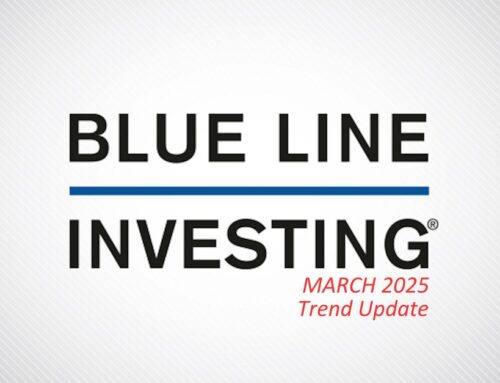Fear defeats more people than any other one thing in the world.
– Ralph Waldo Emerson
I am providing this special update to all BLUE LINE INVESTING® (BLI) clients with hope of helping calm any fear and anxiety during these turbulent and concerning times. To all non-client subscribers, I hope some of my comments benefit you as well.
Since the brief private email sent to BLI clients the other week, I have been hesitant to post comments because I want to be confident that what I am sharing with you is as true and accurate as possible. There is a lot of information being passed around, but I am unsure how much is truly accurate. I want to stress the importance of being very careful of what you read and choose to believe, especially from the MSM. Their news headlines and stories tend to promote greed or fear, both of which can be very detrimental to your long-term investment success. Consider the following headline for example:

I pulled this from a CNBC article published just four months ago. Stop for a minute and let that sink in—just four months ago the media only talked about a rising market. Today, all they talk about is a declining market. All they are doing is stating the obvious. Where is the value?
What I believe is taking place
Based on sources I believe to be reliable, I believe we are dealing with a liquidity crisis. As I understand it, there are an unknown number of bad loans that have been made in the global marketplace, some of which are defaulting. The resulting financial losses to certain organizations and institutions are forcing the sale of anything and everything to raise cash. This would help explain why many domestic stocks, international stocks, commodities, cryptocurrencies, and currencies other than the US dollar, are currently declining.
Why price movements are so large
I believe the market is experiencing a “no-bid” situation. This means there are no buyers—only sellers. When this happens, price movements can be substantial. Price will fall until a level is reached where buyers step in. But remember—just because the stock market is declining doesn’t mean BLI stock strategies are declining by the same percentage.
Actions taken within the BLUE LINE INVESTING® strategies
In the December 2019 primary trend update, I stated I was concerned about the “steepness” of the price rally. If you would like to read that article you can find it here. While our strategies underperformed the market during 2019, part of that was due to our willingness to hold cash equivalents in our stock strategies out of concern of what I believed could be a temporary price top.
In February, the market gave us a Phase 1: WARNING! of a possible change in trend. Shortly thereafter, the market experienced a Phase 2: FAILURE. The use of inverse ETFs within the BLI strategies has helped insulate some of the price decline compared to the broad stock market indexes. This action is not preventing the decline of our strategies but is helping reduce the magnitude of the price decline.
At the time of this writing, all BLI strategies currently have one inverse ETF along with 20-25% invested in cash equivalents. Our strategies are risk managed, meaning there will be times—like now—when our stock strategies are not fully invested. It is very difficult to attempt to “buy low” if you remain fully invested. If you remain fully invested, you have no option other than to go along for the ride—for better or worse.
What I am currently monitoring
While the stock market may seem chaotic at times, I believe it is our goal to try to find the hidden order within the chaos. While there are never any guarantees of success, I believe it can help us make more informed, and hopefully profitable, long-term investment decisions. At this time, it appears the stock market may be experiencing what is called an Elliott Wave 5 Wave correction. The image below illustrates what this may look like:

For those readers who want to read more about this formation, please refer to section 4.5 here. At this time, I believe the current stock market decline is following the black portion of the image above. Based on my calculations, all three of the major US stock market indexes—the Dow Jones Industrial Average, the S&P 500 Index, and the Nasdaq Composite Index—have followed the same wave count up to this point in time. As of the market close on Friday, it may have completed counter-trend wave #4.
The first wave down (labeled #1 above) was -15%.
The counter-trend wave (labeled #2 above) was +10%.
The third wave down (labeled #3 above) was -21%.
The next counter-trend wave (labeled #4 above) was +10%.
If this pattern plays out, we are next awaiting the fifth wave down (labeled #5 above).
IF we reach the target price suggested by wave 5 above, it is my current intention to remove all inverse ETFs and purchase additional stock investments. I believe that could be a reasonable price to buy “lower.” Of course, this is subject to change without notice, and I will make all decisions based on information that is available at that time.
In the past I have made reference that when price rises to high above the Blue Line, it has the historical tendency of acting like a stretching rubber band that eventually “snaps back.” This tendency can also take place once price had declined substantially below the Blue Line. Sometimes the rubber band snaps back quickly, while other times it does so more gradually. Needless to say, I personally believe prices are likely to be higher in the coming months compared to where they are now, but prices may decline further in the short-term before they may begin to turn up.
Additional Comments
At this time, the BLI strategies are predominately invested in Index exchange-traded funds (ETFs). They do not currently hold any individual stocks, and this is by design. Individual stocks can go to zero. The main stock market indexes can not (unless the whole financial system collapses, which I do NOT believe is likely to happen). In addition, it is much easier to add a protective hedge in the form of an inverse ETF to a comparable ETF, compared to the alternative of trying to protect individual stocks. For the most part, that is very difficult.
So much of what I have written in my book covers much of what the markets are experiencing at this time. If everything goes according to plan, it should be published and available for sale the first week in August. I hope you will pick up a copy and reflect on what has been happening over the past six months.
I have further comments I would like to share, but I do not believe it prudent to write them publicly. This may sound strange, but I believe the current decline may be a gift—at least for those investors who did not chase into the rising market last year and remained fully invested.
Don’t despair, and to the best of your ability, do NOT allow headline news to sway your opinion or emotions. Remember, when it comes to investing, one plus one does not always equal two. There are reasons the stock market may be doing what it is doing, for reasons I have not seen anyone in the media discuss. While that does not ensure what I believe will come true, we are weathering the storm better than some. The Financial Times reported over the weekend that Ray Dalio’s largest hedge fund has lost 20% of its value as of the end of last week, and that is before the additional losses of today.
Thank you for reading this special update, and please do not hesitate to call (833) 258-2583 with questions or concerns.
Jeff Link
Disclaimers:
BLUE LINE INVESTING® (BLI) is an actively managed investment process that pursues our mission by combining a trend following investment philosophy and a “buy low, sell high” investment strategy. Our mission is to grow our client’s financial wealth over a full market cycle in a risk-managed and tax-efficient way.
We monitor the relationship between price and the Blue Line over time to help identify which stock markets worldwide are experiencing rising, sideways, and declining primary trends. We prefer to invest in those markets experiencing rising or sideways primary trends, while avoiding those markets experiencing declining primary trends. The Blue Line helps us identify these trends, and when changes may be taking place.
The S&P 500 Index is one of the most commonly followed equity indices, and many consider it one of the best representations of the U.S. stock market, and a bellwether for the U.S. economy. It is comprised of 500 large companies having common stock listed on the NYSE or NASDAQ. The volatility (beta) of the account may be greater or less than the index. It is not possible to invest directly in this index.
Technical analysis is a method of evaluating securities by analyzing statistics generated by market activity, such as past prices and volumes. Technical analysis attempts to predict a future stock price or direction based on market trends. The assumption is that the market follows discernible patterns and if these patterns can be identified then a prediction can be made. The risk is that markets may not always follow patterns. There are certain limitations to technical analysis research, such as the calculation results being impacted by changes in security price during periods of market volatility. Technical analysis is one of many indicators that may be used to analyze market data for investing purposes and should not be considered a guaranteed prediction of market activity. The opinions expressed are those of BLI. The opinions referenced are as of the date of publication and are subject to change without notice. BLI reserves the right to modify its current investment strategies based on changing market dynamics or client needs.
Past performance is not indicative of future results. This material is not financial advice or an offer to sell any product. The information contained herein should not be considered a recommendation to purchase or sell any particular security. Forward looking statements cannot be guaranteed.
Advisory services offered through Aptus Capital Advisors, LLC, a Registered Investment Adviser registered with the Securities and Exchange Commission. Registration does not imply a certain level or skill or training. More information about the advisor, its investment strategies and objectives, is included in the firm’s Form ADV Part 2, which can be obtained, at no charge, by calling (251) 517-7198. Aptus Capital Advisors, LLC is headquartered in Fairhope, Alabama.
ACA-20-61




